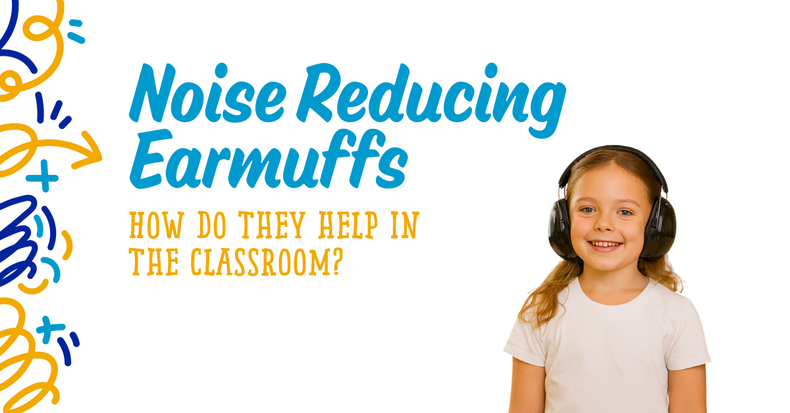Hallways, cafeterias, and busy classrooms can be loud. For some students, that steady noise makes it harder to settle, follow directions, and stay on task. Noise-reducing earmuffs are a simple tool that can help many kids feel calmer so they can focus.
Below is a clear, research-informed guide on why they help, how to choose a pair, and the best ways to use them at school.

Why Classroom Noise Matters
Occupied classrooms commonly sit well above the “quiet” range recommended for learning. Research measuring K–12 rooms found typical background levels in the high 30s to mid-50s dBA during instruction, often higher during active work. That is loud enough to compete with speech, especially for younger students and those with attention or sensory needs.
Do Earmuffs Actually Help?
Studies with autistic children and youth with sensory sensitivities show that reducing background noise can lower arousal and ease problem behaviors. Standard passive earmuffs and active noise-cancelling (ANC) headphones both helped participants cope better in noisy settings, with physiological signs of reduced stress in some trials. Results vary person to person, but the direction of effect is often positive.
That lines up with what many teachers see day to day: when noise is dialed down, students often participate more and last longer in tasks that require focus.

Earmuffs vs. Noise-cancelling Headphones
Both reduce sound, but they work differently.
- Passive earmuffs seal around the ear to block sound. They are durable, do not need charging, and are straightforward for school use.
- ANC headphones (active noise-cancelling) use microphones to counter constant low-frequency noise. They can be great for buses or HVAC hum, but may be less effective for sudden, high-pitched sounds.
Either option can help sensory-sensitive students, so comfort, fit, and school policies should guide the choice.

What is NRR and How Much Reduction do Kids Need?
Noise Reduction Rating (NRR) is the standard number on hearing protectors that estimates how much sound they can block under lab conditions. Higher numbers indicate more reduction, and most consumer earmuffs top out around 30 dB. For school use, many families look for a snug, comfortable set in roughly the mid-20s to high-20s NRR range.
When to use Earmuffs at School
-
Cafeteria and assemblies to take the edge off crowd noise
-
Fire drills and bell transitions to reduce startle and anxiety
-
Independent work or tests if background chatter is distracting
-
Field trips, gyms, or music rooms when sounds spike
The goal is not to wear protection all day. National guidance suggests using hearing protectors when you expect loud settings and keeping them handy for sudden noise. That keeps students engaged with classroom speech while still giving them control when they need it.
The American Academy of Pediatrics also notes that over-ear protection is a safe, practical option for children with audio sensitivity, while earplugs can be a choking hazard for younger kids.
Classroom Tips That Make Earmuffs Work Better
-
Teach the routine. Model when to put them on and how to ask for them.
-
Pair with visuals. A simple card or icon on the desk helps students self-advocate.
-
Use “on-ramps.” Before loud transitions, prompt students to get their earmuffs ready.
-
Check the seal. Glasses and hair can break the seal and reduce effectiveness.
-
Keep communication open. Invite students to remove them during instruction or use one earcup lifted slightly if they need to hear you.
Choosing a Pair: What to Look For
-
Fit and comfort: adjustable headband, cushioned ear cups, light enough for longer wear
-
NRR rating: look in the mid-20s to high-20s for school settings
-
Durability: hinges and sliders that can handle daily use
-
Storage: a simple pouch so they live in a backpack or calm-corner bin
Our Pick for School
Adjustable Protective Earmuffs (28 dB NRR) — comfortable, adjustable, and sized for school use. The 28 dB rating gives solid attenuation without isolating students completely, and the over-ear design avoids the safety concerns of earplugs for younger learners. You’ll find them in the AdaptStore catalog alongside other classroom-ready sensory tools.
Quick FAQ
Will earmuffs block everything?
No. They reduce overall loudness, especially higher-pitched and sudden sounds, but students will still hear voices and important cues when the fit is correct. Results vary by environment and individual sensitivity.
Can wearing them all day cause problems?
Long, continuous wear is usually unnecessary in class and may make it harder to hear instruction. Use them during known loud periods or when a student requests a break from noise. Follow your school’s guidelines and your student’s plan.
Are they only for autistic students?
No. Many learners benefit during loud events or work periods, including students with ADHD, anxiety, or auditory processing challenges. The research base includes autistic youth and shows reduced stress responses when noise is attenuated.


